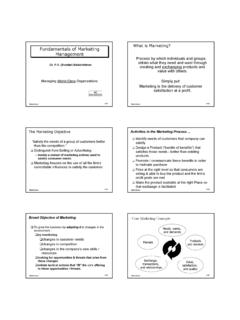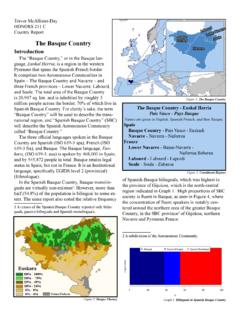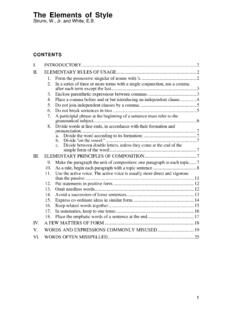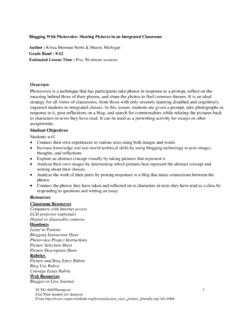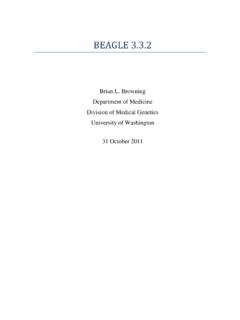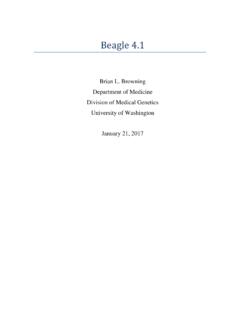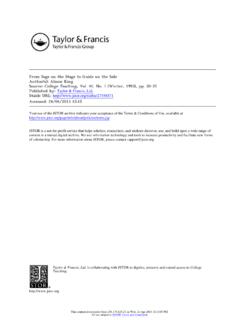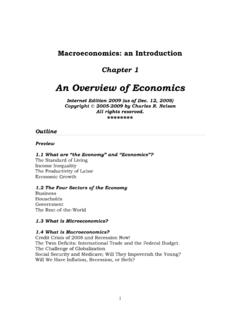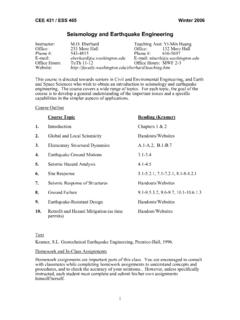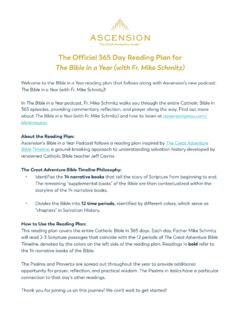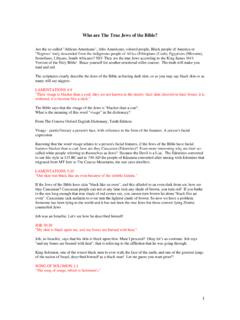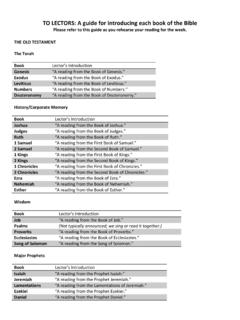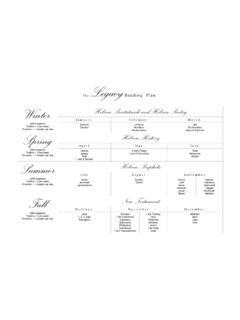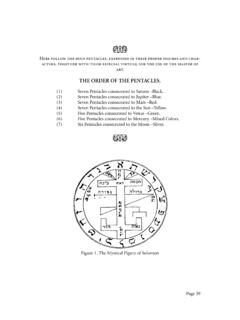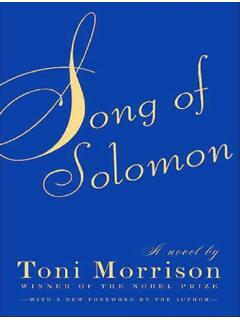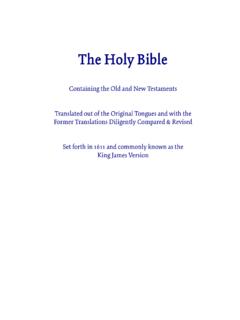Transcription of The Song of Songs: Translation and Notes
1 The Song of songs : Translation and NotesOur Translation of the Song of songs attempts to adhere as closely as pos-sible to the Hebrew text. As such, we follow the lead set by Everett Fox, most prominently, in his approach to Translation . In addition, we have attempted to utilize common English words to render common Hebrew words and rare English words to render rare Hebrew words (see Notes h and ac, for example). We also follow Fox s lead in our representation of proper names. Throughout this volume we have used standard English forms for proper names (Gilead, Lebanon, solomon , etc.)
2 In our Translation , however, we have opted for a closer representation of the Hebrew ( , Masoretic) forms (Gil ad, Levanon, Shelomo, etc.). We further believe that the Masoretic paragraphing should be indicated in an English Translation , and thus we have done so in our presentation of the text. While we consider (with most scholars) the Aleppo Codex to be the most authoritative witness to the biblical text, in this case we are encumbered by the fact that only Song 1:1 3:11 is preserved in the extant part of the Aleppo Codex. Accordingly, we have elected to follow the paragraphing system of the Leningrad Codex.
3 Setuma breaks are indicated by an extra blank line. The sole petuh a break in the book, after 8:10, is indicated by two blank lines. The Aleppo Codex, as preserved, has petuh a breaks after 1:4 and 1:8, whereas the Leningrad Codex has setuma breaks in these two places. As for the remain-ing part of the Song of songs in the Aleppo tradition, we note a difference of opinions by the editors responsible for the two major publications of the Aleppo Codex at one place. Mordecai Breuer (Torah, Nevi im, Ketuvim [Jerusalem: Mosad Ha-Rav Kook, 1989], ) indicates a setuma break after 4:11, which is also reflected in the Leningrad Codex; the Keter Yerushalayim volume (notwithstanding its nod to Breuer on the title page) has no break of any sort at this juncture (737/ ).
4 We also have introduced different fonts in our Translation to reflect the different characters present in the Song of songs , as follows: -187 -188 solomon S VINEyARd Minion Pro is used for the two principal characters, with the more flowing italic Minion Pro used for the dominant female voice and the regular Minion Pro used for the responsive male voice. The superscription in 1:1 is indicated by Garamond. The lines spoken by the chorus are produced in Gill Sans. The few lines spoken by the brothers, 8:8 9, in the mouth of the female, are indicated by that one cannot be absolutely certain about the attribution of all the spoken lines to a particular character (male lover, female lover) or group (chorus, brothers).
5 Such uncertainty, however, probably is germane for only about 10 percent of the lines. In most cases, when the second-person mas-culine singular forms (verbs, pronouns, etc.) are used, we assume that the female lover is speaking, addressing her beloved. Conversely, when the sec-ond-person feminine singular forms are used, we assume that the male lover is , observe that there are two sets of Notes accompanying our trans-lation. The lettered Notes (a, b, c) refer to general literary uses, while the numbered Notes (1, 2, 3) refer specifically to issues relevant to the hij and ta b b genres raised in chapter 4.
6 Translation ANd Notes 1891. Or, in light of the object of the invective, the song of songs concerning She-lomo. See also the references to this wealthiest of kings in 1:5; 3:7, 9, 11; 8:11, The poet begins immediately with the wine imagery that will flow throughout the poem, a feature that the Song of songs shares with Arabic hij The female lover Notes that other women love the male protagonist as well, both here and in the final stich of the next verse. See also 6:9, though in this passage we learn that other women acclaim the female lover. The praise by others, external to the main characters, is another feature of hij poetry, on which see chapter 4, pp.
7 152 53. 4. Given the hij quality of the poem, we opt to retain MT here (see ch. 4, p. 141) and thereby reject the oft-proposed emendation to Salma. 5. The sons of my mother, of course, is a poetic way of stating brothers (who would have to be full brothers, not half-brothers). Given that brothers can refer to political allies in Biblical Hebrew (see ch. 4, pp. 157 58), we suggest that a political reading may be inherent here, as befitting the overall charges within hij The Song of Songs1:1 The song of songs , which is Shelomo :2 May he kiss me with the kisses of his mouth, For your love is better than 21:3 To the scent of your good oils, Turaq oil b is your name; Therefore the maidens love :4 Draw me, after you let us run.
8 The king has brought me to his chambers, Let us be glad and let us rejoice in you, Let us recallc your love more than wine, (More than) smooth-wine, they love :5 Black am I, and comely, O daughters of Yerushalayim; Like the tents of Qedar, Like the curtains of The shift from third person in the first stich to second person in the second stich sounds odd to English ears, but this is common in Hebrew The Hebrew word turaq remains an enigma. Presumably it describes a par-ticularly fine type of The Hebrew root zkr typically means remember, thus our rendering recall.
9 But a homonymous root, which serves as the basis for the common word z k r male, bears a sexual connotation. Accordingly, a second meaning is evident as well, something like let us make-love your love. 190 solomon S VINEyARdpoetry. Among other relevant passages in the Song of songs , see, for example, 8:1 with brother meaning ally. 6. The first of numerous references to vineyards, orchards, and gardens within the Song of songs , which is also characteristic of hij poetry in the Arabic tradition (see ch. 4, pp. 147 49). See also 1:14; 2:13, 15; 4:12, 13, 15, 16; 5:1, 13; 6:2, 11; 7:13; 8:11 12, The Hebrew root hb love is used for fealty in a political sense throughout the Bible, and we suggest that this undertone is present in the Song of songs as well (see ch.)
10 4, p. 157).8. The double meaning in this word and the Janus parallelism inherent in this verse is treated in note e (see also , pp. 13 14). yet a third connotation is present, however. The verbal root r y can bear both humans as the subject, in which case the sense is shepherd, and animals as the subject, in which case the sense is graze. With the latter sense, however, the meaning can be extended to devastate (< overgraze ), and thus this passage also contains a veiled critique of the king; see chapter 4, p. 153. 9. One does not necessarily expect military terminology within love poetry, but 1:6 Do not look at me, that I am dark, That the sun has glared at me; The sons of my mother were angry at me, They set me as keeper of the vineyards, (But) my own vineyard I have not :7 Tell me, O whom my inner-beingd loves,7 Where do you desire/shepherd?
